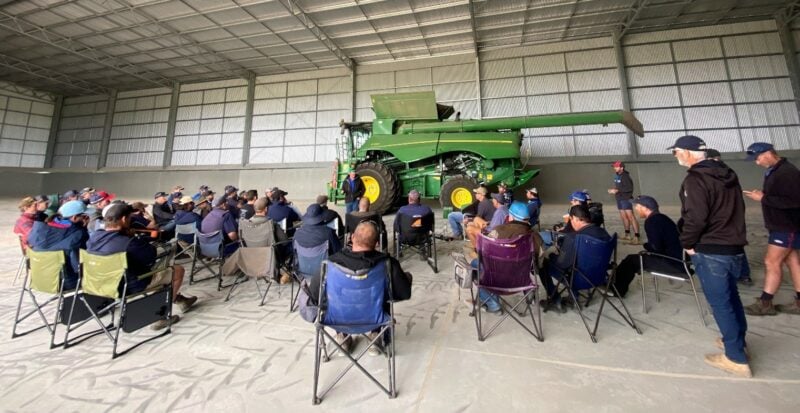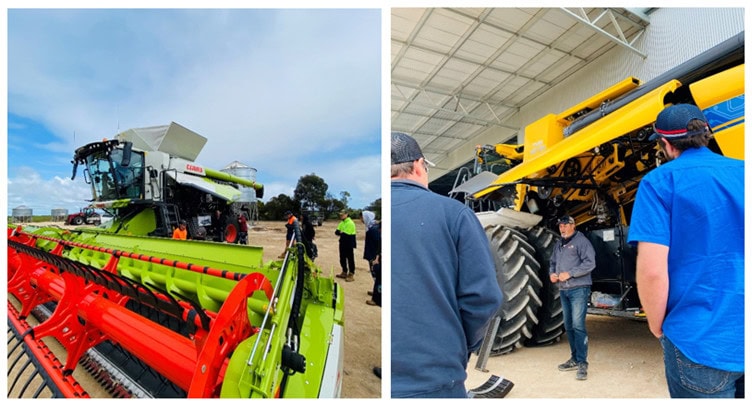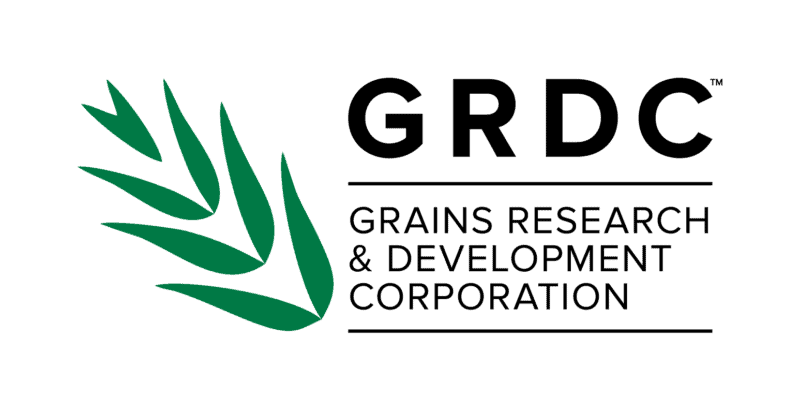GRDC Harvester Clinic roadshow sweeps the EP
There’s no denying combine harvesters are serious business. As new header prices inch towards the $2 million mark (don’t forget to add the front!), it’s just as well accountants don’t mind aggressively depreciating farm assets to make the numbers work harder.
Machinery prices have been a hot topic of conversation for farming businesses since the Covid haze, and it’s interesting how much opinions vary. Many find it hard to fathom how prices continue to rise, while others understand it’s the cost of doing business in a modern economy.
What seems to be universally agreed upon is – whatever the machine you purchase, it has to be working at its greatest potential.
And so last week, a team of independent experts put harvesters and fronts firmly under the microscope, with the sole objective: “improve farmers knowledge to maximise header performance and efficiency, whilst minimising grain loss”.
And by gosh…didn’t they come! Over 140 farmers and 50 industry stakeholders supported the GRDC Harvester Clinics held in Kimba, Wudinna and Cummins from 18 to 20 September. With almost 200 registered participants attending in total, late catering calls were made to ensure we could keep up with the demand.
Harvest grain loss was first on the agenda, with facilitators asking for an indication on how many are already measuring grain loss at harvest. To my surprise, there were very few raised hands – in saying that, it was the number one reason why most individuals were attending.

To help paint the picture on the importance of measuring grain loss, Kondinin Group’s Ben White stated,
“Each farmer is estimated to lose as much as one road train load of grain, per year due to harvester loss – whether that be from the front of the machine, or the back”.
For mixed farmers, this may not be as significant due to summer feed potential. But if you have a problem with mice, having a high volume of grain left behind, in comparison to standard baiting rates, may give you headaches.
Experts were regularly asked the question “How many times do you recommend measuring grain loss during harvest?” Independent expert, Brett Asphar provided the audience with a good example of harvesting in a similar, tough season with small, white grains in most crops.
To ensure they were minimising losses, drop trays were checked three (3) times every box full. While this seemed extreme, Brett was demonstrating the importance of how continual adjustments and observations can be vital in seasons like this.
As a general rule of thumb, Brett suggested header operators place trays at three (3) different points around the machine. This will identify where header losses are coming from, and will enable operators to make adjustments to the right areas whether that be the header front, the back and/or sides.
While delivering the Header 101 session, Brett emphasised the importance of operators treating their headers as individuals, in a rather unique way.
“One of my mates is married to a very nice lady, and she has a sister. He cannot stand the woman. He can’t even be in the same room as her. But even though they come from the same factory, they are completely different people. Your headers are no different.”
Having spent the morning session filling their GRDC notebooks with hints, tips and tricks, most welcomed the morning tea break to avoid RSI in their writing hand. The break provided a fantastic opportunity for attendees to share thoughts and ideas, and ask direct questions to industry experts.
“It’s been fantastic to get independent advice, rather than being told what you want to hear” – farmer, Wudinna.
Following the break, attendees formed smaller groups around their harvester brand of choice to hear from experts Murray Skayman (New Holland), Kassie van der Westerhuizan (John Deere) and Brett Asphar (Case).
This part of the day reminded me of watching a group of kids enjoying a Lego playdate. All having fun, with a side of competition.
Johnny arrives with his set and tells everyone he likes green the best “because nothing runs like a Deere”.
Ramsey Jnr peels open his cardboard box and boldly declares “everyone knows that red goes fastest. Case closed”
Little Holland can’t stand red or green and states “only yellow will do – it always looks shiny and New”
Finally, a German exchange student appears in Cummins – I think his name is Clause or Claas? He pulls out his “pea n ham soup” coloured Lego kit and says “Wenn die Feuchtigkeit stimmt, machen wir die ganze Nacht”.
Johnny, Ramsey Jnr and Little Holland stare at each other in silence.
Did somebody say KFC?


All jokes aside, this practical learning opportunity was incredible to witness. The speakers, farmers, facilitators, funding providers and industry representatives all engaged with so much enthusiasm towards sharing knowledge and improving current practices.
“I’ve been to other header clinics, and this was by far better. The independent recommendations are so valuable” – Case owner, Cummins
The afternoon session covered several more topics including front end losses, harvest weed seed control, grain storage and hygiene, fire risk and prevention. It was interesting to hear various causes of (previous) header fires from farmers in each district, and prevention methods they have since adopted.
In recognition of the increased lentil production on EP, a farmer attending from the Yorke Peninsula shared his experience in avoiding fires when harvesting lentils by recommending operators “reap into the wind as much as possible”. In the event of a fire, facing the header into the wind can be the difference between keeping or losing the header entirely.
As a result of attending the Harvester Clinics, the majority of farmers and header operators stated they intend to:
- Start measuring grain losses throughout harvest using drop trays
- Make easy modifications to header to improve efficiency this harvest
- Recalibrate sensors based on information received at clinic
- Pay attention to location of trapped straw in header front, and make adjustments to prevent in future
Many thanks to funding providers GRDC and Birchip Cropping Group for bringing the clinics to the region.
Additional thanks to our farmer hosts and those that provided headers and fonts for demonstration. The events could not have happened without your assistance and support.
Online Resources
https://grdc.com.au/resources-and-publications/resources/harvest-resources
https://www.youtube.com/@primarysalesaustralia5748/videos
Speakers
Brett Asphar: (M) 0427 213 389 (E) brett.asphar@gmail.com
Kassie van der Westerhuizan: (M) 0459 785 690 (E) office@oneshotharvest.com.au
Murray Skayman (Canada)
Kelly Ingram: (M) 0429 860 415 (E) kelly@seedterminator.com.au
Ben White: (Ph) 1800-weevil (E) ben.white@kondinin.com.au
Peter Broley: (M) 0458 458 053 (E) pbroley@primarysales.com.au
Chris Bazeley: (M) 0428 990 973 (E) cbazeley@primarysales.com.au


